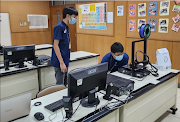Twenty-five science teachers and eleven mathematics teachers from Rizal High School, Sta. Lucia High School, and North Fairview High School attended a three-day orientation-workshop on Collaborative Lesson Research and Development (CLRD) from May 17 to 19, 2010. CLRD is NISMED’s adaptation of Lesson Study, a Japanese professional development model for teachers where teachers collaborate to develop “research lessons.”

Dr. Soledad A. Ulep, Deputy Director for Research and Extension, orients
the teacher-participants on the CLRD process.
the teacher-participants on the CLRD process.
The goal of the orientation-workshop was to gain insights on teachers’ content and pedagogical content knowledge as well as their teaching practices and beliefs. This included interviews on how a particular lesson is taught, how students would answer a particular question, and the discussion of their students’ answers to the diagnostic test given by NISMED.
The participants were introduced to teaching strategies called ‘teaching mathematics through problem solving’ and ‘teaching science through inquiry’. NISMED staff demonstrated the essentials of these strategies to the participants. The teachers also viewed videos of an actual lesson exemplifying the strategies.
The participants were also introduced to the CLRD process that includes the procedures and protocols in the selection of topics to be taught, lesson planning, lesson implementation, post lesson discussion, and lesson revision. The lessons will then be implemented by another teacher. Lessons developed through this collaborative process are called research lessons.
On the last day of the orientation-workshop, the participants and NISMED staff together formulated the CLRD goals and subgoals for the first year of implementation. For mathematics,the goal is for students to value mathematics by developing their thinking skills. The subgoals are: to represent real-life and mathematical situations; to give meaning to mathematical representations; and to solve problems in many ways.
For science, the goal is to develop and nurture self-directed learners who have enduring understanding of science concepts that can be applied to real-life situations. The subgoals are: to ask questions and find answers to their questions; to communicate ideas; and to participate actively in class activities and discussion.
Soon after the workshop, NISMED drafted guidelines and instruments for use in the different activities of the collaborative lesson research and development.





0 Comments